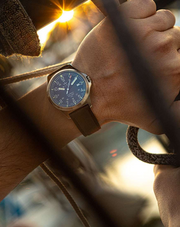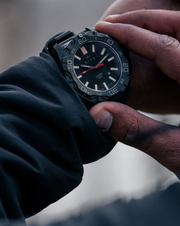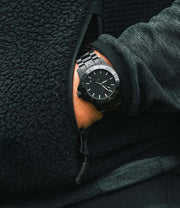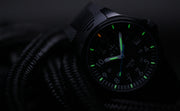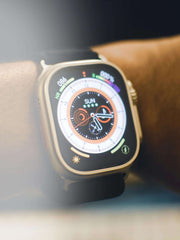Key Takeaways
- Our 300m rating means genuine performance - not just laboratory numbers that disappoint in real use
- Most water resistance failures happen during normal activities, swimming and showers, not extreme depths
- Dynamic pressure beats static testing, real water activities create forces lab tests don't replicate
- Quality sealing matters more than big numbers, our triple-gasket systems prevent most water damage
- Conservative ratings protect you, we rate our watches so they exceed expectations, not disappoint
- Professional dive watches need 200m minimum, serious underwater work demands proven performance
Why Our 300m Water Resistance Rating Actually Delivers
We rate our Alpha series watches at 300 metres water resistance because they genuinely perform at these depths and beyond. Unlike manufacturers who inflate ratings for marketing purposes, our conservative approach ensures real-world performance exceeds stated specifications. As one of the best water resistant watches manufactured in Britain, our timepieces combine Swiss precision with British military heritage.
When we test our Alpha Sunrise at 300 metres water resistance, we're providing you with a rating based on actual capability rather than optimistic laboratory conditions. This represents the fundamental difference between our engineering philosophy and industry standard practices.
After two decades of supplying equipment to those who can't afford failure, we understand that watch durability isn't just about impressive specifications. It's about creating dive watch features that work when conditions turn challenging, whether you're exploring British coastlines or operating in demanding environments worldwide.
Our approach focuses on delivering water resistance that works in real conditions, not just passing minimum laboratory requirements. We design our watches for genuine underwater performance rather than marketing demonstrations that bear little resemblance to actual use.
Why Standard Water Resistance Ratings Fail Customers
Watch ratings often mislead customers about real-world capabilities. We've documented expensive watches flooding during basic swimming because people misunderstood these ratings.
The fundamental problem isn't depth ratings themselves, it's the testing methodology. Laboratory conditions use static pressure chambers that don't replicate dynamic forces generated during actual swimming. Each stroke creates pressure spikes that can instantly exceed the watch's rated capacity.
This watch buying guide reality check matters because choosing the wrong timepiece can ruin adventures and cost serious money.
How Laboratory Testing Fails Real-World Applications
Standard water resistance testing occurs in controlled environments that poorly represent actual use conditions. Watches remain stationary in pressure chambers filled with air rather than water, whilst gradual pressure increases simulate depth exposure.
Real swimming generates dynamic pressure fluctuations as arms move through water. Each stroke creates pressure spikes that can momentarily exceed rated capacity. Most water damage occurs not from extreme depths but from thermal shock, transitioning between hot and cold environments causes gasket materials to expand and contract, creating moisture entry points.
Our UK-based testing programme subjects timepieces to actual British marine conditions, from cold Scottish lochs to the warmer waters off Cornwall. Temperature variations from 3°C to 19°C stress gasket materials beyond typical manufacturer testing protocols.
Quality manufacturers account for real-world factors by incorporating substantial safety margins into designs. Conservative engineering ensures performance exceeds stated specifications.
Our Triple-Gasket Sealing Technology
The fundamental difference between watches that survive genuine water exposure and those that fail lies in sealing system quality. We employ advanced gasket technology rather than basic configurations that appear adequate on paper but fail under pressure.
Our Alpha collections utilise triple-gasket sealing systems that create multiple barriers against water ingress. Unlike single-gasket designs found in cheaper alternatives, our approach ensures that if one seal fails under pressure, secondary barriers maintain water resistance.

We specify premium gasket materials rather than basic rubber compounds used by mass-market manufacturers to reduce costs. Our compounds resist degradation from salt water, cleaning chemicals, and temperature extremes encountered around British coastlines.
Screw-down crown technology provides significant advantages over standard push/pull mechanisms. The threaded design creates mechanical compression that maintains seal integrity under pressure fluctuations common during dynamic water activities.
Our Conservative Rating Philosophy
Our approach to water resistance ensures real-world performance exceeds promised specifications. When we rate Alpha series watches at 300 metres, they perform reliably at depths well beyond stated capacity. This conservative philosophy comes from our military background, where under-promising and over-delivering keeps people safe.
We test every timepiece individually before dispatch rather than sampling batches like larger manufacturers. This comprehensive approach ensures each watch meets NITE specifications rather than hoping your particular unit performs as advertised.
Our military heritage demands absolute reliability. When UK Special Forces selected our MX10 as standard issue equipment, this represented operational necessity rather than marketing opportunity.
Professional Diving Standards and Requirements
Serious underwater work requires timepieces meeting ISO 6425 standards for diving watches. These specifications mandate minimum 200 metre water resistance, but more importantly, testing under conditions that simulate actual diving stresses.
Professional diving creates unique challenges for watch water resistance. Rapid pressure changes during ascent and descent stress case construction beyond recreational swimming forces. Extended underwater exposure tests gasket sealing under prolonged pressure conditions.
 The Alpha Z series represents our latest diving watch technology evolution. The 42mm case houses Swiss Ronda 715 quartz movements within robust sealed construction designed for demanding underwater operations.
The Alpha Z series represents our latest diving watch technology evolution. The 42mm case houses Swiss Ronda 715 quartz movements within robust sealed construction designed for demanding underwater operations.
Commercial diving organisations increasingly specify our timepieces for professional training where equipment reliability prevents accidents. This adoption reflects confidence in engineering quality that professional divers trust with their safety.
Understanding Pressure Ratings for Different Activities
| Water Resistance | Safe Activities | Notes |
|---|---|---|
| 3 ATM (30m) | Hand washing, rain exposure | Swimming will cause water damage |
| 5 ATM (50m) | Light swimming, showering | Exercise caution with temperature changes |
| 10 ATM (100m) | Swimming, snorkelling | Confident water use begins here |
| 20 ATM (200m) | Professional water activities | Enhanced water resistance for demanding use |
| 30 ATM (300m) | Professional diving | Our Alpha series delivers true diving capability |
Dynamic pressure during swimming can instantly exceed static ratings. Each swimming stroke creates pressure spikes that stress gasket sealing beyond laboratory test conditions. This explains why 30-metre rated watches fail during pool activities despite seemingly adequate depth ratings.
Temperature shock represents another common failure mode. Moving between hot and cold environments causes gasket materials to expand and contract, creating temporary gaps where moisture penetrates.
Advanced Materials and Construction
Premium water resistance depends on material science that creates durable sealing systems. Our gasket compounds resist common failure modes that affect standard rubber seals over extended use.
Sapphire crystal selection provides superior impact resistance compared to mineral glass alternatives. Enhanced durability prevents crystal damage that could compromise water resistance during active use.
Proven Performance in Professional Applications
We've established our reputation by delivering watches that perform when conditions become challenging. Marine rescue professionals report successful performance from NITE timepieces during emergency operations where equipment reliability saves lives.
Professional diving instructors consistently praise real-world performance from our Alpha collection during training programmes. Customer reports from throughout Britain highlight successful performance during diverse activities, from North Sea diving expeditions to Cornish surfing adventures.
Our tritium illumination technology combines with superior water resistance to create timepieces that excel in challenging underwater conditions. Continuous illumination remains visible during deep water operations where traditional luminous materials fail.
Maintenance and Long-Term Performance
NITE's superior engineering creates meaningful maintenance advantages through materials that resist degradation longer than standard alternatives. Premium gasket compounds maintain sealing effectiveness between required service intervals.
We support our confidence with a comprehensive five-year warranty programme covering manufacturing defects. Unlike competitors who exclude water damage from coverage, NITE's protection acknowledges responsibility for delivering promised performance.
How to Choose the Right Water Resistant Watch
For diving watches UK customers trust, our Alpha series delivers professional-grade performance that exceeds ISO 6425 certification standards. Whether swimming in chlorinated pools, surfing in salt water, or diving in challenging British waters, our water resistance technology provides confidence that standard manufacturing approaches cannot match.
When you need equipment that continues working when everything else fails, NITE's engineering excellence delivers genuinely trustworthy performance. Forged in Britain's independent tradition and proven in demanding environments, our timepieces represent more than Swiss made movements and premium materials.
Discover our complete Alpha collection and experience the difference proper water resistance engineering makes.
Frequently Asked Questions
What does 300m water resistance mean? 300m water resistance means the watch can withstand pressure equivalent to 300 metres underwater depth. NITE's 300m rating ensures genuine performance at stated depths, unlike optimistic ratings that fail under real-world conditions.
Can I swim with a 50m water-resistant watch? Yes, but exercise caution. A 50m rating supports brief shallow swimming, but avoid aggressive swimming or diving. Dynamic pressure from swimming can exceed static test conditions, potentially causing water damage to watches with basic sealing systems.
How often should I check my watch's water resistance? Check your watch's water resistance every 2-3 years or after significant impact. Gasket materials degrade over time, and sealing effectiveness diminishes without proper maintenance. NITE's UK service team can perform these checks using appropriate equipment.
Why do watches fail during normal swimming activities? Watches fail during swimming because laboratory testing uses static pressure that doesn't replicate dynamic forces. Each swimming stroke creates pressure spikes that can momentarily exceed the watch's rated capacity. NITE designs watches with substantial safety margins beyond stated ratings.
What makes NITE Alpha series superior for water activities? NITE Alpha series uses conservative rating methodology, premium gasket materials, and triple-sealing systems that provide safety margins beyond stated specifications. UK-based testing includes actual marine conditions rather than laboratory parameters only.
Should I wear my watch in hot showers? Avoid wearing your watch in hot showers. Hot water creates thermal shock that can compromise gasket seals. Rapid temperature changes cause materials to expand and contract, potentially creating gaps where moisture can penetrate.





